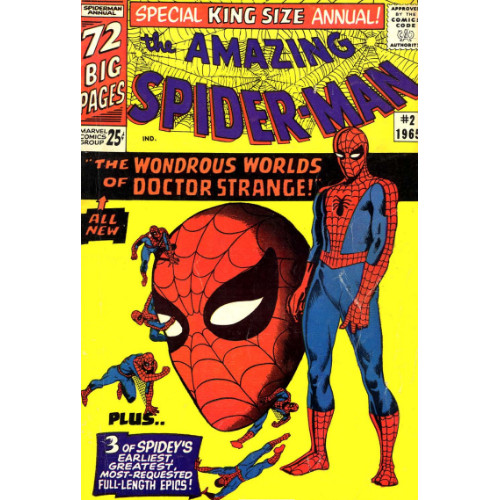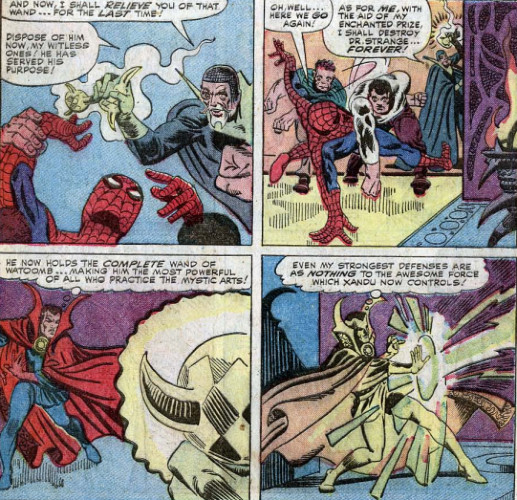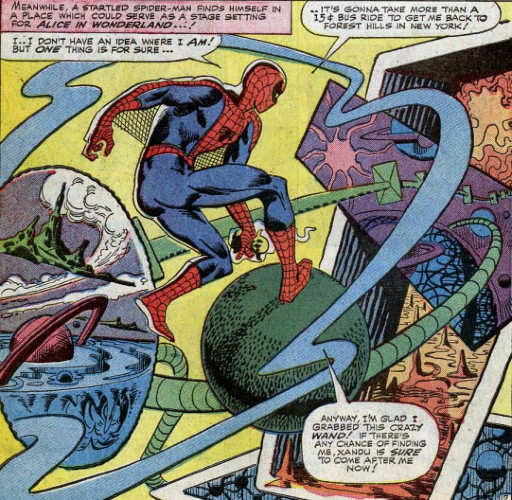Crawling Back: Amazing Spider-Man Annual #2 Review
A somewhat generic tale defines Spidey and Doctor Strange's first team-up, the story failing the annual's impressive artistry
—by Nathan on February 11, 2024—

It's no question that Spider-Man is artist Steve Ditko's greatest co-creation, in terms of popularity and pop culture influence. Walk around your local Target and spot all the Spidey backpacks, toys, birthday decorations, and you'll see what I mean. What other Marvel hero has eight live action movies, two animated films, and a plethora of animated TV series and video games to his name? Sony isn't trying to create a film franchise outta Captain America's rogues gallery! Rights issues aside, even if the question came up, you can bet any studio would latch onto Spidey's greatest adversaries over any other hero's villains, except maybe Batman. Ditko invented many other characters during his career–the Creeper, Hawk and Dove, the Question, Blue Beetle–but none so impactful or iconic as Spider-Man. When’s the last time you saw Doctor Strange birthday decorations at your local Target? Maybe a balloon exists somewhere out there with Benedict Cumberbatch wiggling his fingers. "Hope your birthday's magical!" he says to little Timmy.
Still, you can bet Spidey beats out the good doctor in a popularity contest any time. Heck, that may have been true back in 1965, when this second Amazing Spider-Man annual was published. And because both men owe their existence, in part, to Ditko, it seemed inevitable that the Web-Head and the Master of the Mystic Arts would cross paths at some point.
I have, periodically, posted reviews of the closing chapters in a narrative I can only refer to as the "Wand of Watoomb Saga." Very early in my "Spider-view" reviews, I analyzed a story involving the Scarlet Witch, the penultimate chapter in a story I recently wrapped up by reviewing the Spider-Man/Dr. Strange: The Way to Dusty Death graphic novel. I thought it appropriate to backtrack to the beginning and outline the opening chapter in the Watoomb "epic," started 27 years before Roy Thomas put the finishing touches (and, eh, in some cases "finishing" touches) on a series of skirmishes involving our favorite teenage superhero from Queens, the magician of Bleecker Street, and the mad wizard Xandu.
"The Wondrous Worlds of Doctor Strange"
Writer: Stan Lee
Penciler: Steve Ditko
Inker: Steve Ditko
Colorist: Stan Goldberg
Letterer: Sam Rosen
Issue: Amazing Spider-Man Annual #2
Issue Publication Date: July 1965

I have vague memories of encountering this issue for the first time. Much like my formal introduction to Spidey's Silver Age antics through his very first annual, I consumed this little piece of graphic literature through a merry Marvel Masterworks volume. I couldn't tell you my initial impressions, but I can state that though I've recalled this narrative often enough over the ensuing years, I've never let it linger through my mind as much as that first perilous adventure with the Sinister Six.
Re-examining the narrative again more recently, I can clearly see why: though "Wondrous Worlds" is an offbeat, psychedelic yarn which plays to Ditko's creative strengths, it's not nearly as memorable a story. Doctor Strange and Spidey, aside from their shared creator, have little in common, particularly at this point. This isn't "We need a mentor figure for Spidey" such as the role served by Benedict Cumberbatch in No Way Home, slotting the character into a position previously filled by Tony Stark and, to a much lesser extent, Nick Fury (and, in a more twisted sense, Mysterio). We don't have the "two hot-headed teenagers" comparison like we can make between Spidey and the Human Torch, or the "fight street level crime, swing around the city, and wear red" similarities we find between Spidey and Daredevil. Spidey, largely because he's more accustomed to that street level association with crimefighting, feels somewhat at odds with the occasional mystical component lobbed his way. Those elements fit in his wheelhouse as naturally. This is comics, however. If some writer wants a hero's (and an audience's) comfort zone to expand a little, they'll make it stretch.

Not that Lee and Ditko fail to fully incorporate the mystical elements into the issue. The annual's greatest sequence sees Spidey, having stolen the issue's McGuffin, temporarily banished to an interdimensional crossroads of sorts, Ditko now having the opportunity to cut loose with the visuals. Aptly aided by Goldberg's vivid palette, Ditko draws in all manner of foreign spherical objects and seeming gateways to other realms. That Spidey then duels with a couple of brainwashed toughs allows the sequence some entertaining action, throwing out the naturally accepted laws of physics for whatever visuals Ditko believes best play with the sequence.
Yet, save for these battles, the story's heavier magical elements are best left to Doctor Strange, who combats Xandu on his own. Their fight is flashy, tendrils of light swirling about and causing all manner of havoc. Yet save for Spidey's occasional interference, we actually don’t get much interaction between our two primary heroes. This isn't a particularly memorable first meeting between the pair, and I wonder if, because each man represents such diversely different strains of comic book storytelling methods, Lee and Ditko struggled a little in determining how best to bring them together. The pair eventually do team, going their separate ways at issue's end. But you don't feel much of a connection forged between them or a sense that they'll bump into each other often. Maybe at the occasional superhero costumed shindig.

The annual's antagonist, Xandu, is left with little backstory, in favor of the issue's plethora of battle sequences. A single panel during the issue's final page offers the merest hint at his past, folding into the style of "former practitioner of magic becomes corrupt and turns evil" storytelling characters such as Baron Mordo and, I'm sure, a dozen other villains Doctor Strange has confronted the last 60 years have endured. Much of Xandu's character development occur in later issues, including the two I've already reviewed. As noted previously, I was surprised to learn Xandu actually returned, more than once, and received an increasingly complicated backstory. There's no hint whatsoever at his longevity here, meaning that having a one-and-done villain turn into a more viable threat down the line is an entertaining surprise. As you see from some other Lee/Ditko narratives of the era, the reveling in certain characters comes from knowing who those characters will become later or later learning of those characters' continued impact, especially when you least expect it.
Xandu's thugs are not much to write home about either, serving as nameless goons (literally, a database I found only refers to them as "Xandu's two unnamed minions") who never appear after this issue. I did feel a slight sense of empathy for them I neglected when I first read the issue, noting that, while these guys are hulking brutes in the middle of a bar fight when we first meet them, they don't deserve to be mind controlled by a wizard. They're tough punks, giving Spidey a run for his money. No, they're not the Juggernaut, the Rhino, or however many other bruisers Spidey's combated over the years, but they're surprisingly solid. Do note the color of the one thug's shirt–green, with lines–which was changed to yellow for at least the Masterworks reprint, a recoloring decision made, I'm assuming, because the green veered too close to the color scheme of a certain sandy supervillain.

There certainly is a sense little forethought went into the development of this issue. The plot is paper thin, the McGuffin generic, the villain better remembered for his later appearances, his henchmen lost to the sands of time. Spidey and Strange spend most of the issue apart, fighting their own battles, and when they do eventually "team up," there’s not much physical interaction or relationality created between the two men. I can certainly see the issue’s appeal: it's Ditko given a chance to bring his creations together, putting Spidey and Doc Strange on the same page for the first time (Strange's cameo appearance in the first annual doesn't count, as he merely spooked Flash Thompson and his buddies, never physically interacting with Spidey). And it ends up being Ditko's art which carries the annual, crafting remarkable sequences of interdimensional insanity.
"72 Big Pages" the cover touts about this issue. This story takes up 20 of those pages, the rest resigned to some fun biographies of members of Spidey's rogues gallery (like the Crime-Master, the Beetle, and the Circus of Crime), and reproductions of some of Spidey's first adventures: saving John Jameson in ASM #1, battling the terrible Tinkerer, and confronting Doctor Doom for the first time. Contrast this with the first annual, where the Sinister Six escapade was double in length. Is it too much to ask an annual to provide a story at least somewhat longer than what we receive in a standard issue? A shame that Lee and Ditko weren't wizards like their mustachioed magician; no chance to whip up a longer plot with a simple "Abracadabra!" or (more fittingly) a cry of "By the hoary hosts of Hoggoth!"